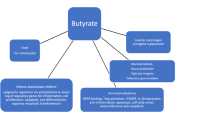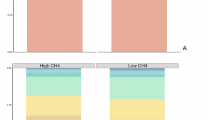Abstract
Dietary fibres have been shown to affect early-life microbiota colonization in the large intestine of suckling piglets, however, much less is known as to whether they also modulate the composition and activity of butyrate-producing bacteria. Here, we investigated the effect of dietary fibres on the abundance, composition, and activity of butyrate-producing bacteria in suckling piglets. Piglets were fed a control diet or creep feeds containing alfalfa, wheat bran, or pure cellulose, respectively, from postnatal day 7 to 22. Large intestinal digesta and mucosa samples were collected for quantitative analysis of bacterial group-specific 16S ribosomal RNA- and butyrate production-related genes, and digesta samples for quantification of short-chain fatty acids. The alfalfa diet increased (P < 0.05) Clostridium cluster XIVa abundance, copies of genes encoding proteins involved in butyrate production (butyryl-CoA:acetate CoA-transferase, butyrate kinase), and butyrate concentration compared to the wheat bran diet in the digesta of the proximal colon. In the distal colonic digesta, animals fed the alfalfa diet had the highest number of butyryl-CoA:acetate CoA-transferase gene copies (P < 0.05) and numerically the highest butyrate concentration, albeit not significant (P > 0.05), compared to other groups. In the distal colonic mucosa, the cellulose diet increased (P < 0.05) the abundance of Clostridium cluster XIVa and copies of the butyryl-CoA:acetate CoA-transferase gene compared to the alfalfa diet. These results indicated that dietary fibres modulate the abundance and activity of butyrate-producing bacteria in the large intestine of suckling piglets, and that a moderate supplementation of alfalfa and cellulose may benefit early-life gut health through the delivery of butyrate to the mucosa.




Similar content being viewed by others
References
Ben David Y, Dassa B, Borovok I, Lamed R, Koropatkin NM, Martens EC, White BA, Bernalier-Donadille A, Duncan SH, Flint HJ, Bayer EA, Morais S (2015) Ruminococcal cellulosome systems from rumen to human. Environ Microbiol 17:3407–3426
Bensoussan L, Morais S, Dassa B, Friedman N, Henrissat B, Lombard V, Bayer EA, Mizrahi I (2017) Broad phylogeny and functionality of cellulosomal components in the bovine rumen microbiome. Environ Microbial 19:185–197
Bian GR, Ma SQ, Zhu ZG, Su Y, Zoetendal EG, Mackie R, Liu JH, Mu CL, Huang RH, Smidt H, Zhu WY (2016) Age, introduction of solid feed and weaning are more important determinants of gut bacterial succession in piglets than breed and nursing mother as revealed by a reciprocal cross-fostering model. Environ Microbiol 18:1566–1577
Chen H, Mao XB, He J, Yu B, Huang ZQ, Yu J, Zheng P, Chen DW (2013) Dietary fibre affects intestinal mucosal barrier function and regulates intestinal bacteria in weaning piglets. Br J Nutr 110:1837–1848
Deng WK, Wang YB, Liu ZX, Cheng H, Xue Y (2014) HemI: a toolkit for illustrating heatmaps. PLoS ONE 9(11):e111988
Drochner W (1993) Digestion of carbohydrates in the pig. Arch Tierernahr 43:95–116
Flint HJ, Bayer EA, Rincon MT, Lamed R, White BA (2008) Polysaccharide utilization by gut bacteria: potential for new insights from genomic analysis. Nat Rev Microbiol 6:121–131
Furusawa Y, Obata Y, Fukuda S et al (2013) Commensal microbe-derived butyrate induces the differentiation of colonic regulatory T cells. Nature 504:446–450
Guo X, Xia X, Tang R, Zhou J, Zhao H, Wang K (2008) Development of a real-time PCR method for Firmicutes and Bacteroidetes in faeces and its application to quantify intestinal population of obese and lean pigs. Lett Appl Microbiol 47:367–373
Han KS, Balan P, Gasa FM, Boland M (2011) Green kiwifruit modulates the colonic microbiota in growing pigs. Lett Appl Microbiol 52:379–385
Konstantinov SR, Awati AA, Williams BA, Miller BG, Jones P, Stokes CR, Akkermans ADL, Smidt H, De Vos WM (2006) Post-natal development of the porcine microbiota composition and activities. Environ Microbiol 8:1191–1199
Louis P, Flint HJ (2007) Development of a semiquantitative degenerate real-time PCR-based assay for estimation of numbers of butyryl-coenzyme A (CoA) CoA transferase genes in complex bacterial samples. Appl Environ Microbiol 73:2009–2012
Louis P, Flint HJ (2009) Diversity, metabolism and microbial ecology of butyrate-producing bacteria from the human large intestine. FEMS Microbiol Lett 294:1–8
Louis P, Duncan SH, McCrae SI, Millar J, Jackson MS, Flint HJ (2004) Restricted distribution of the butyrate kinase pathway among butyrate-producing bacteria from the human colon. J Bacteriol 186:2099–2106
Louis P, Hold GL, Flint HJ (2014) The gut microbiota, bacterial metabolites and colorectal cancer. Nat Rev Microbiol 12:661–672
Matsuki T, Watanabe K, Fujimoto J, Miyamoto Y, Takada T, Matsumoto K, Oyaizu H, Tanaka R (2002) Development of 16S rRNA-gene-targeted group-specific primers for the detection and identification of predominant bacteria in human feces. Appl Environ Microbiol 68:5445–5451
Matsuki T, Watanabe K, Fujimoto J, Takada T, Tanaka R (2004) Use of 16S rRNA gene-targeted group-specific primers for real-time PCR analysis of predominant bacteria in human feces. Appl Environ Microbiol 70:7220–7228
Metzler BU, Mosenthin R (2008) A review of interactions between dietary fiber and the gastrointestinal microbiota and their consequences on intestinal phosphorus metabolism in growing pigs. Asian-Australas J Anim Sci 21:603–615
Metzler-Zebeli BU, Zijlstra RT, Mosenthin R, Ganzle MG (2011) Dietary calcium phosphate content and oat beta-glucan influence gastrointestinal microbiota, butyrate-producing bacteria and butyrate fermentation in weaned pigs. FEMS Microbiol Ecol 75:402–413
Mu CL, Yang YX, Zhu WY (2015) Crosstalk between the immune receptors and gut microbiota. Curr Protein Pept Sci 16:622–631
Pryde SE, Duncan SH, Hold GL, Stewart CS, Flint HJ (2002) The microbiology of butyrate formation in the human colon. FEMS Microbiol Lett 217:133–139
Rajilic-Stojanovic M, de Vos WM (2014) The first 1000 cultured species of the human gastrointestinal microbiota. FEMS Microbiol Rev 38:996–1047
Rinttila T, Kassinen A, Malinen E, Krogius L, Palva A (2004) Development of an extensive set of 16S rDNA-targeted primers for quantification of pathogenic and indigenous bacteria in faecal samples by real-time PCR. J Appl Microbiol 97:1166–1177
Rooks MG, Garrett WS (2016) Gut microbiota, metabolites and host immunity. Nat Rev Immunol 16:341–352
Sokol H, Pigneur B, Watterlot L et al (2008) Faecalibacterium prausnitzii is an anti-inflammatory commensal bacterium identified by gut microbiota analysis of Crohn disease patients. Proc Natl Acad Sci USA 105:16731–16736
Suzuki MT, Taylor LT, DeLong EF (2000) Quantitative analysis of small-subunit rRNA genes in mixed microbial populations via 5 ‘-nuclease assays. Appl Environ Microbiol 66:4605–4614
Tremaroli V, Bäckhed F (2012) Functional interactions between the gut microbiota and host metabolism. Nature 489:242–249
Tudela CV, Boudry C, Stumpff F, Aschenbach JR, Vahjen W, Zentek J, Pieper R (2015) Down-regulation of monocarboxylate transporter 1 (MCT1) gene expression in the colon of piglets is linked to bacterial protein fermentation and pro-inflammatory cytokine-mediated signalling. Br J Nutr 113:610–617
Velasquez-Manoff M (2015) Gut microbiome: the peacekeepers. Nature 518:S3–11
Wang XF, Mao SY, Liu JH, Zhang LL, Cheng YF, Jin W, Zhu WY (2011) Effect of gynosaponins on methane production and microbe numbers in a fungus-methanogen co-culture. J Anim Feed Sci 20:272–284
Zhang LL, Mu CL, He XY, Su Y, Mao SY, Zhang J, Smidt H, Zhu WY (2016) Effects of dietary fibre source on microbiota composition in the large intestine of suckling piglets. FEMS Microbiol Lett 363:fnw138
Acknowledgements
The work was partly supported by the Natural Science Foundation of China (31430082), China-EU project (1008) and the Royal Netherlands Academy of Sciences, KNAW (09CDP006). We furthermore would like to thank the European Framework Programme 7 for support through project “INTERPLAY” (Project No. 227549).
Author information
Authors and Affiliations
Corresponding author
Ethics declarations
See Methods
Conflict of interest
The authors declare no competing financial interest. All applicable international, national, and institutional guidelines for the care and use of animals were followed. All procedures performed in studies involving animals were in accordance with the ethical standards of the institution or practice at which the studies were conducted. This article does not contain any studies with human participants performed by any of the authors.
Electronic supplementary material
Below is the link to the electronic supplementary material.
Rights and permissions
About this article
Cite this article
Mu, C., Zhang, L., He, X. et al. Dietary fibres modulate the composition and activity of butyrate-producing bacteria in the large intestine of suckling piglets. Antonie van Leeuwenhoek 110, 687–696 (2017). https://doi.org/10.1007/s10482-017-0836-4
Received:
Accepted:
Published:
Issue Date:
DOI: https://doi.org/10.1007/s10482-017-0836-4




